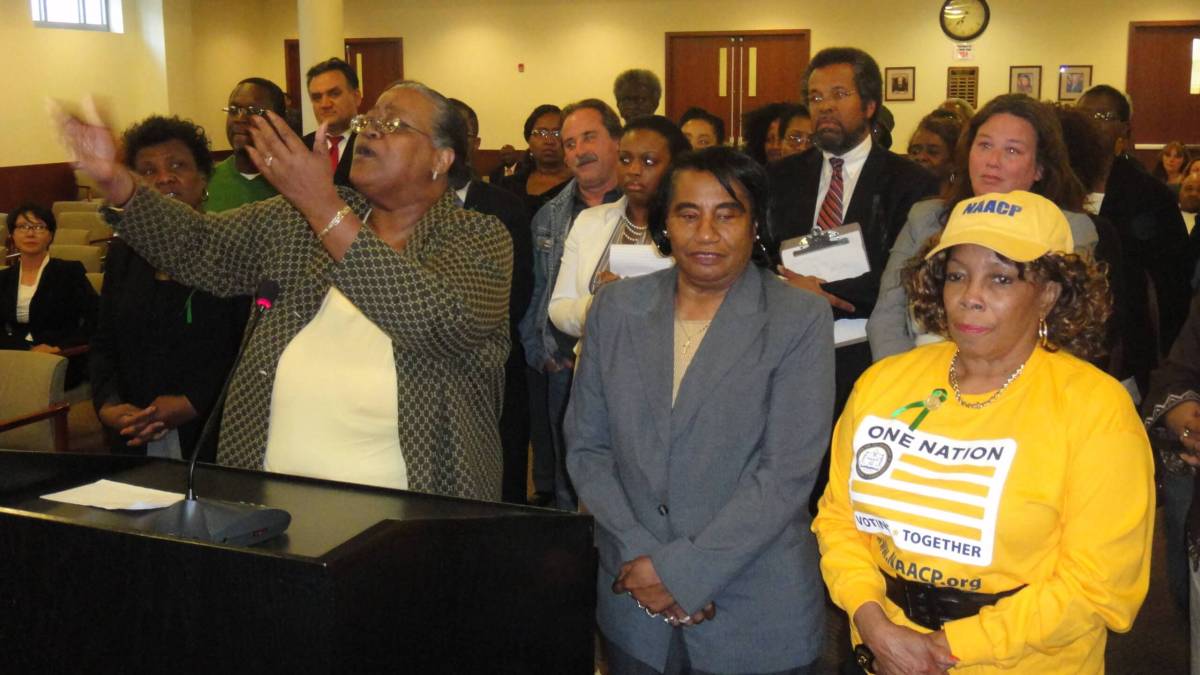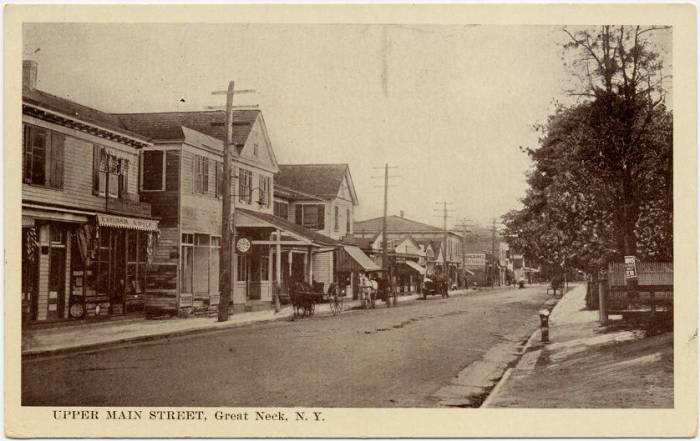
Nassau County Republican lawmakers say they are just following the letter of the law in redrawing the county’s 19 legislative districts just weeks after the U.S. Census results came in. Democrats are calling for criminal investigations into the process and accuse the local GOP of gerrymandering to maintain their 11-8 majority after next Election Day.
Neither side of the aisle is likely to see eye to eye. The complex process—which traditionally comes after an lengthy review by a special commission—is destined for court challenges before the proposed map comes up for a vote May 16. Local civic leaders who packed the chamber of the Theodore Roosevelt Legislative Building in Mineola Monday for the lone public hearing on the redistricting made clear they too have drawn a line in the sand.
“My village is one of the smallest geographic villages in the county—we’re just a third of a square mile—yet the district lines cut my village in half,” said Great Neck Plaza Mayor Jean Celender. Since the Nassau County Legislature was created in 1994, the Great Neck peninsula has been represented by one legislator.
Democratic strongholds like the Gold Coast share that complaint with minority districts to the south, although Presiding Officer Peter Schmitt (R-Massapequa) said the goal of the new map is to ensure greater representation for more ethnically diverse neighborhoods.
“We’re not going to stand for you ramming this down our throats,” shouted Hempstead Village Mayor Wayne Hall, whose village would be split from two districts into three under the plan. Among the changes, Terrace Avenue would fall under the 8th district in Garden City.
“What do we have in common with Garden City?” one man from Hempstead shouted. “We get arrested if we go there!”
Great Neck and Hempstead are just some of the areas getting scrambled. Almost half of Nassau residents, some 44 percent, are affected by the redesign but Schmitt ordered County Attorney John Ciampoli to draw the new lines without delay.
“This negates any real input from the public,” said Legis. Judi Bosworth (D-Great Neck). “By the time that they understand this is an issue…it will be voted, signed, sealed and delivered.”
Republicans, who took control of the legislature after the 2009 elections for the first time in 10 years, deny playing politics. They insist the county charter supports their timetable.
“One person, one vote,” said Schmitt. “I’m not a lawyer…the Supreme Court has made this decision and I’m required to follow it.”
Among his central arguments are that census data revealed the heavily minority 2nd district is now over-populated and needs more minority representation.
The new map also merges the two current 5th and 19th districts on the South Shore—represented by Legis. Joseph Scannell (D-Baldwin) and Legis. Dave Denenberg (D-Merrick), respectively—and makes a new minority-centric 19th district along the Nassau-Queens border.
“If I’m truly working on an empowerment plan here, I remove the 800-pound gorilla from the arena,” Ciampoli says of the proposed 19th legislative district, which would stretch from South Floral Park down to Inwood.
The gorilla to which Ciampoli refers would likely be one of the incumbents—Scannell and Denenberg would have to primary one another to keep their seats, or move into a new district. Ciampoli says Legis. John Ciotti (R-Valley Stream) was not included in the new district in order to give the minority population the chance to put up two fresh candidates.
“In all probability, if I drew John Ciotti into the new 19th district, he would win it,” Ciampoli says.
Back at the hearing, things were less certain. Typically mundane question-and-answer periods often degenerated into shouting matches. Tempers flared to the point that police officers were brought in to make sure a fight didn’t break out.
“What is happening to us in Nassau County?” H. Scottie Coads, of the local NAACP chapter, said as she sulked in her chair after waiting for hours to speak. “I’ve never seen anything like it.”
From the Backroom to the Courtroom
Well aware that they lack the votes to stop redistricting from passing the legislature, Nassau Democrats filed a lawsuit this week at state Supreme Court in Mineola requesting a judge to block the vote scheduled for Monday on the redistricting bill.
They argue that hastily pushing through a temporary redistricting plan violates the county charter as well as both the state Constitution and the U.S. Constitution while the nominating period for the November elections is less than a month away.
“There is no such provision, there is no such need for a temporary plan, and no matter what you say the process calls for a set of hearings around the communities being affected,” said state and Nassau Democratic Chairman Jay Jacobs, adding he “absolutely expects to win” the court challenge.
Republican leaders were not swayed.
“They’re whining and crying,” said Schmitt, referring to his Democratic critics. His reaction to a lawsuit: “Bring it on!”
While the outcome of the legal challenges unfold, the Democratic leadership in the legislature also alleged potential criminal wrongdoing surrounding the redistricting process. Legis. Diane Yatauro (D-Glen Cove), the outgoing minority leader, wrote letters to Nassau County District Attorney Kathleen Rice and state Attorney General Eric Schneiderman requesting investigations into how the new map was made and funded.
“We are deeply troubled that illegal steps may have been taken to produce the rushed and illegitimate map,” Yatauro said.
Rice and Schneiderman declined to comment. Nor has Schmitt weighed in.
Ciampoli says he hired two outside consultants who constructed the map. They include David Schafer, who has also been hired by Republican state lawmakers on the state-level redistricting process, and Debra Levine, the co-executive director of the New York State Legislative Task Force on Demographic Research and Reapportionment, which provides technical support for state Senate, Assembly and Congressional redistricting.
Ciampoli says both are experts in the field.
History Repeated
Watching the hearing Monday very closely from either side of the podium were two women seasoned in such intense political battles.
Hempstead Town Councilwoman Dorothy Goosby successfully sued her town, which prompted the creation of council districts instead of the at-large system used in many townships across Long Island.
“I think they [referring to Schmitt and Ciampoli] both are misinformed,” said Goosby, who represents the Hempstead, Roosevelt and Uniondale communities on the town board. “They did not bring the public in. They act like dictators.”
Goosby rallied her supporters to voice their outrage at the Republican redistricting plan. But throughout all the heckling, she remained silent, just staring at the lawmakers.
More in the thick of it was Legis. Judy Jacobs (D-Woodbury), who oversaw the redistricting process a decade ago when the Democrats had the majority and she was presiding officer.
At one point during Monday’s hearing, Ciampoli and Jacobs—armed with decade-old notes from the last map drawing—got into a heated exchange.
“Legislator Jacobs, let me make a point, the final plan is adopted in 2013,” said Ciampoli, referring to a bi-partisan commission that will oversee another, more permanent redistricting process next year before being finalized the year after that.
“And Mr. Ciampoli, can I make a point?” Jacobs asked. “That is so nice of you to have legislators run on one plan right now and then out of the goodness of your heart give them another plan to run on in two years.”
Some experts questioned the need to do redistricting twice.
“We’re developing plans in a few weeks, whereas in most states and cities it takes a couple of months to prepare a map properly,” says Jeffrey M. Wice, a national redistricting attorney who represented the Democratic side of the Board of Supervisors in 1994 and the legislature’s Democratic caucus during the last redistricting cycle.
“You’re much more prone to mistakes and missing pieces if you do this too fast.”

































